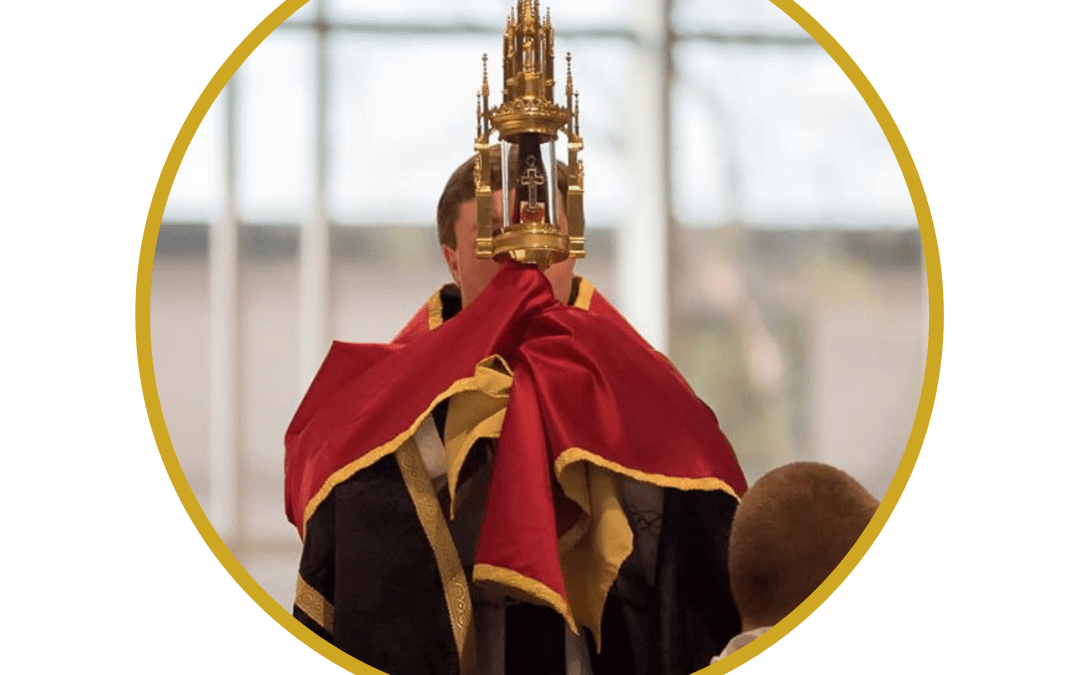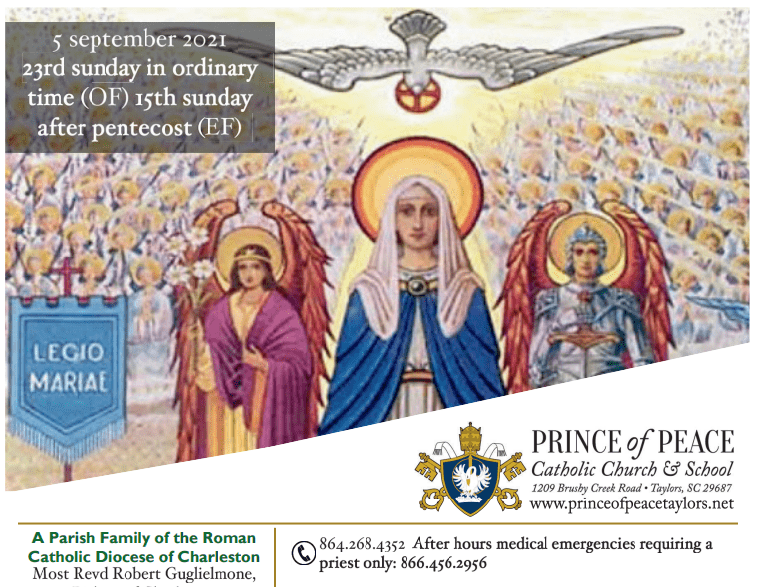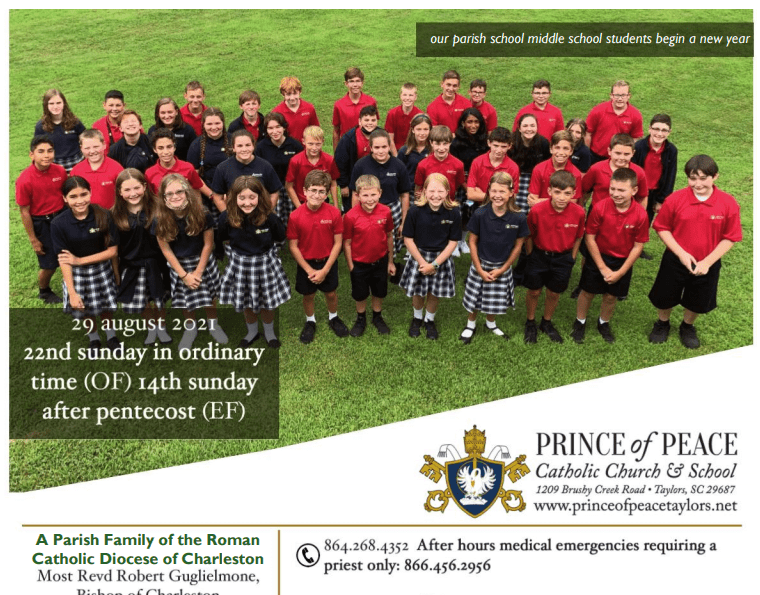
19 September 2021 Bulletin
Read this week’s bulletin: 19 September 2021

Read this week’s bulletin: 19 September 2021

14 September: Feast of the Exaltation of the Holy Cross. This feast commemorates three historical events: finding of the True Cross by Saint Helena; dedication of the churches on the site of the Holy Sepulchre and Mount Calvary; and restoration of the True Cross to Jerusalem by Heraclius II. After the Resurrection, Jewish and Roman authorities hid the Holy Sepulchre, Christ’s tomb. Earth was mounded up and pagan temples built on top. Tradition said Christ’s Cross had been hidden nearby. Saint Helena (Constantine’s mother) was divinely inspired to travel to Jerusalem in 326 to find the True Cross. Three crosses were eventually found. Helena and Saint Macarius, bishop of Jerusalem, devised an experiment to determine which was the True Cross. The crosses were taken to a woman near death; when she touched the True Cross, she was healed. Another tradition says the body of a dead man was laid upon each cross. The True Cross restored the man to life. Constantine constructed churches at the Holy Sepulchre and Mount Calvary. Those churches were dedicated and the Feast of the Exaltation of the Holy Cross was celebrated. The feast slowly spread, until, by the year 720, it was universal. In the 7th century, Persians conquered Jerusalem and captured the Cross. Heraclius II defeated them and restored the Cross to Jerusalem. Tradition says he carried the Cross on his own back, but when he attempted to enter the church on Mount Calvary, a strange force stopped him. Patriarch Zacharias of Jerusalem advised him to take off his royal robes and crown and to dress in penitential garb instead. As soon as Heraclius did so, he was able to carry the Cross into the church. Truly, this feast day is a celebration of God’s greatest work: His death and resurrection which defeated death and opened Heaven. Christ transformed an instrument of torture and humiliation into a symbol of salvation. When Moses lifted up the bronze serpent over the people, it was a foreshadowing of salvation through Jesus when He was lifted up on the Cross. To follow Christ we must take up His cross, follow Him and become obedient until death. We make the Sign of the Cross which helps to fix our minds and hearts on God. At Baptism, we are sealed with the Sign of the Cross, signifying our redemption and that we belong to Christ. Let us look to the cross frequently, and realize that when we make the Sign of the Cross we give our entire self to God — mind, soul, heart, and body. The antiphon for today says it perfectly: “We should glory in the cross of our Lord Jesus Christ, for he is our salvation, our life and our resurrection: through him we are saved and made free.”
Ideas for celebrating this feast day at home:

Click to read the 12 September 2021 Bulletin

8 September: Feast of the Nativity of the Blessed Virgin Mary. This feast day commemorates the birth day of Mary. There are only three birthdays on the liturgical calendar: Mary, Jesus, and John the Baptist. Usually, it is the custom to celebrate the feast day of a saint on the date of their death as that marks their “birth” into everlasting life. Mary, however, entered the world sinless (known as the “Immaculate Conception”). She was born to be the mother of the Savior of the world, the spiritual mother of all men, and the holiest of God’s creatures. Mary is called the firstborn of the redeemed and her nativity is “the hope of the entire world and the dawn of salvation” (Pope Paul VI, Marialis Cultus). Mary’s birth is not recorded in scripture but is found in the Protevangelium of James, an apocryphal writing from the 2nd century. The liturgical celebration of this feast has a joyous theme of light: the world that had been shadowed in the darkness of sin sees a glimmer of light with the arrival of Mary. Through Mary comes Christ, the Light of the World. The Blessed Virgin has a pivotal role in the history of salvation, and she was given the highest mission ever commended to any creature. We rejoice that the Mother of God is our Mother, too. Today and every day, let us often call upon the Blessed Virgin as “Cause of our joy”, one of the most beautiful titles in her litany.
There are some wonderful traditions from around the world that are associated with Our Lady’s birthday. Since September 8 marks the end of summer and beginning of fall, this day has many thanksgiving celebrations attached to it. In the older form of the Roman Ritual there is a blessing of the fall planting seeds. The winegrowers in France called this feast “Our Lady of the Grape Harvest.” The best grapes are brought to church to be blessed and then some bunches are attached to hands of the statue of Mary. A festive meal which includes the new grapes is part of this day. In the Alps section of Austria this day is “Drive-Down Day” during which cattle and sheep are led from their summer pastures in the slopes and brought to their winter quarters in the valleys. This was usually a large caravan, done with decorations and festivity. In some parts of Austria, milk from this day and all the leftover food are given to the poor in honor of Our Lady’s Nativity.
Ideas for celebrating this feast day:
(sources: Excerpts from The Holyday Book by Fr. Francis Weiser, catholicculture.org, catholiccuisine.blogspot.com)

Click to read the 5 September 2021 Bulletin!

Click to read this week’s bulletin: 29 August 2021 Bulletin
Recent Comments